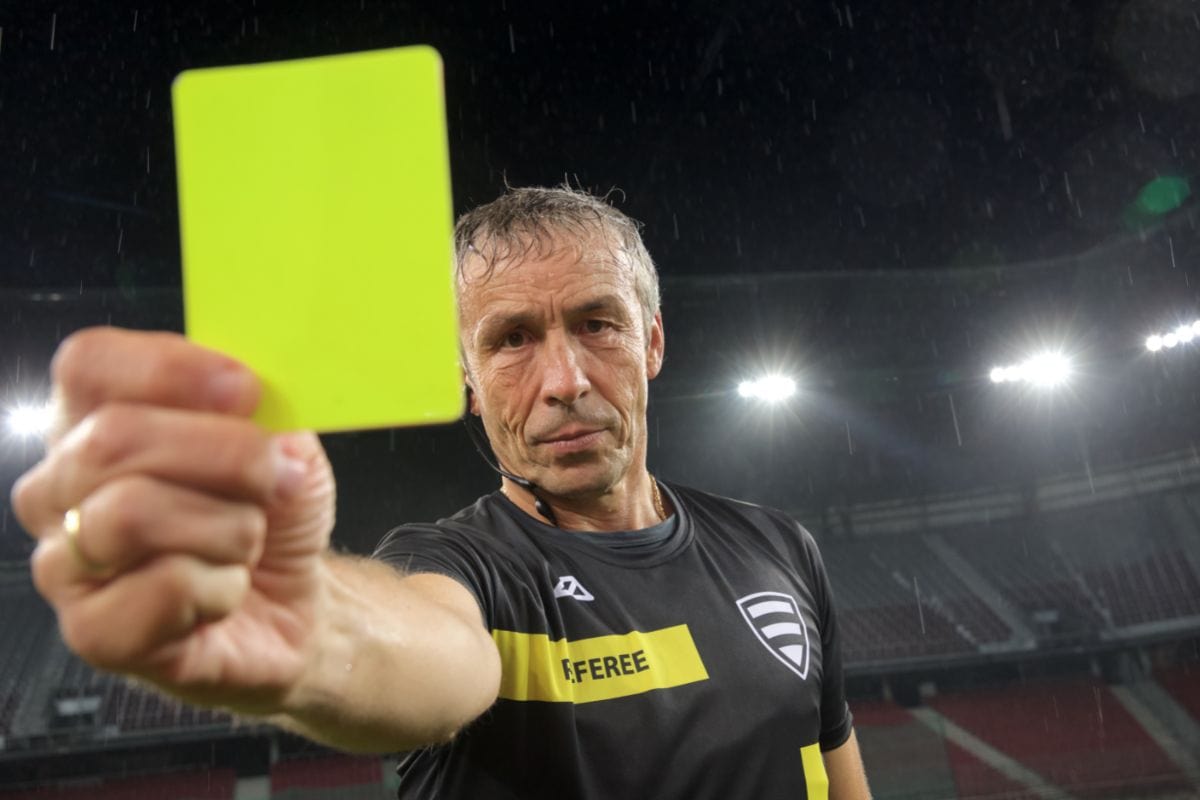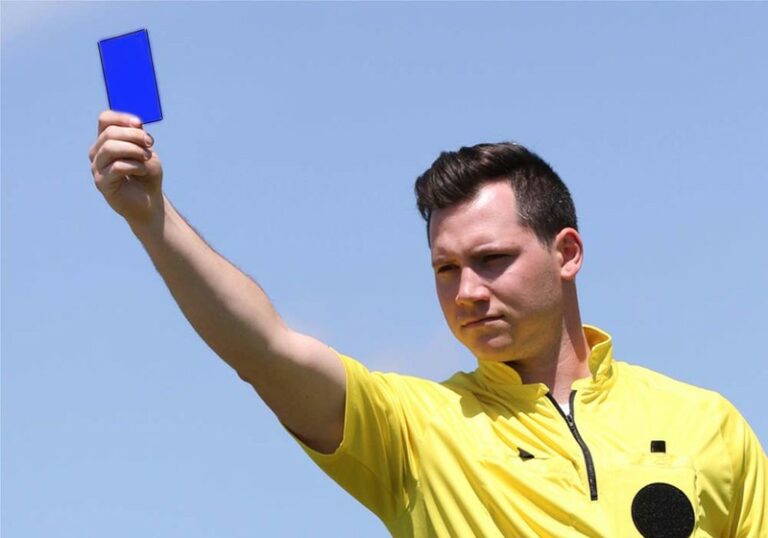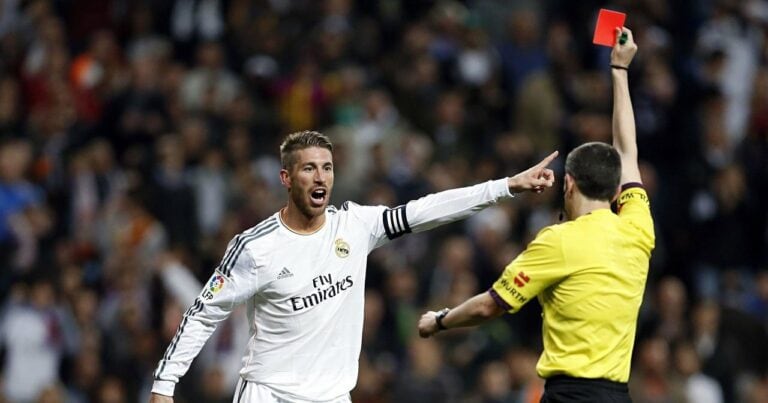Soccer is one of the most popular sports in the world, but its long history of tactics and rules can be overwhelming for someone learning. If you’ve just started watching or playing soccer, every now and again you will see a referee blow their whistle and present a player with a yellow card.
This is usually accompanied by a roar from the crowd and many protests from players on the field. So what exactly has happened here? What does it mean when a referee presents a player with a yellow card? If you’re wondering about this, then you’ve come to the right place!
In this article, we’re going to give you a total guide on what a yellow card means. We’ll take you through some of the histories, the rules in the modern version of the game, and some important moments in the history of soccer involving yellow cards.
We’ve also made sure to include some other information about soccer, as well as an extensive Frequently Asked Questions section to help explain anything else you might need to know at the end.
Rules In Soccer
To begin, let’s outline why there are rules in soccer. Every game—be it sports, or even board games—has a set of rules that players must follow. This is to stop the game in question from descending into chaos. Soccer is no different, and over the years it has accumulated a lot of different rules.
Some of the most important rules in soccer revolve around ‘foul play’ (breaking of rules, especially making contact with other players), and ‘off-side’ (whether or not a goal has been legitimately scored). In the modern, most popular version of soccer (football) there are a few basic rules.
- A soccer (football) team consists of no more than 11 players on the field at any given time, including one who is the goalkeeper.
- The game will begin with a coin toss, and the winner of the coin toss decides who takes the first kick-off.
- In the event the ball crosses the sideline, the team who did not touch it last gets to throw it back onto the field.
- Players are not allowed to touch the ball with anything other than their feet, head, or chest. The goalkeeper is the only person who is allowed to touch the ball with their hands, and only within the goal area.
- A Match is played in two halves, each being 45 minutes.
- Goals will not be allowed if they are ‘offside.’
Also Read: The Best Turf Soccer Shoes
Referees In Soccer
But how are these rules enforced in a game? Well, this is all to do with the referee. You can think of a referee in soccer (football) as the person who administers the rules of the games and ensures that they are followed.
They are also responsible for a whole host of other important parts of the game, including before or after, as well as the person who makes important decisions about the course of the game. Soccer players are expected to listen to and respect a referee at all times.
Referees watch for potential fouls and can stop the game at any point in order to enforce the rules. This is usually done with a system of cards and eventually suspensions. In the next section, we’re going to take a close look at the yellow card and what it means for a game of soccer.
The Yellow Card
A yellow card in soccer can be considered a warning or a caution. When a player fouls, the referee will blow his whistle and stop the game. Then, he will move towards the player who committed the foul, take a yellow card from his pocket, and present it to the entire field.
A yellow card, in this case, is a warning to that player that they are in danger of having further action taken because of their behavior on the pitch. At this point, you’re probably wondering what kind of behavior on the field can result in a yellow card.
This is usually up to the referee’s discretion, however, there are a few common behaviors that referees are taught to look out for. These include:
- Intentional or repeated breaking of rules.
- Leaving or entering the field without the referee’s discretion.
- Delaying the resumption of play after a break.
- Verbal or physical abuse.
- General unsportsmanlike behavior.
- Not keeping the right distance from a corner or during a free-kick.
So if a player commits any of these (and the referee spots them) then there’s a good chance that they will receive a yellow card. If two yellow cards are presented by the referee to the same player within a game, then they will get a red card and they must leave the game immediately.
So now let’s take a look at a red card, to compare it to a yellow card, in order to get a better understanding of both.
Also Read: What is Relegation In Soccer & What Does It Mean
The Red Card
A red card means immediate removal from the field. This usually occurs when a player has done something that is blatantly against the rules, or they are endangering another player.
When a player gets a red card, they can no longer be replaced by a member of their team by way of substitution and the team will have to play on with one person down. This is one of the reasons why teams very much try to avoid getting a red card.
In fact, professional players can sometimes get into big trouble if they get a red card during an important moment in a game.
Let’s take the World Cup, for example, and imagine two teams playing in the final. If a player gets a red card in this circumstance, then they put their team at a major disadvantage.
Getting Two Yellow Cards
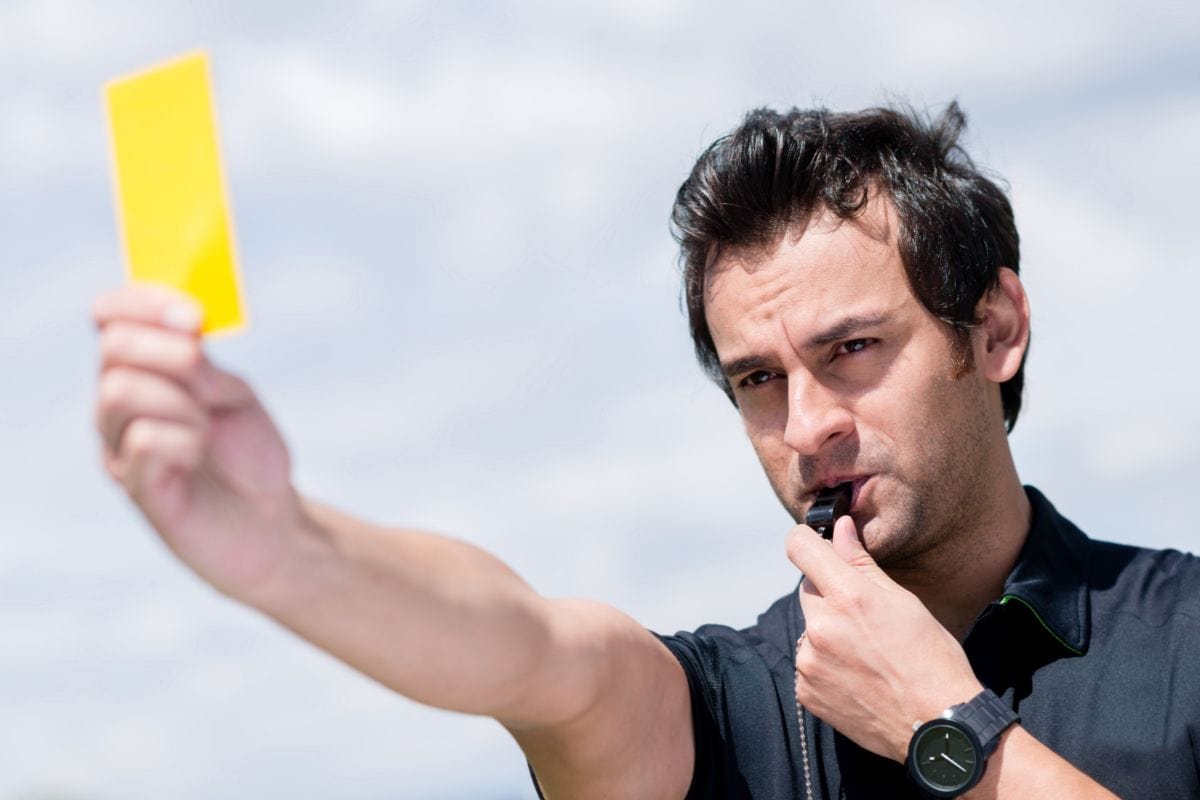
So then, in a game of soccer, a player is able to get shown two yellow cards in a row. This happens when a player commits one offense, then another after. This can be at any time during the game.
Two yellow cards mean that they will then get a red card, and leave the field immediately. After this, they are likely to be suspended for the next time.
How Long Does A Yellow Card Last For?
Let’s say you’re a player who has unfortunately been shown a yellow card. Perhaps you made a bad tackle and the referee has decided to penalize you for it. If this has happened, you probably have some questions!
How long does this card follow you around? Are you going to have to be on your best behavior now?
You should always endeavor to be respectful and calm during games of soccer, but mistakes happen from time to time, and you can get a yellow card through an accident or momentary lapse of judgment.
Either way, you’ll need to be careful with the rest of the game as once you have received a yellow card, you will be cautioned for the entire game. Yellow cards do not disappear during halftime or any other part of a game.
We’ve already outlined what happens when you get two yellow cards, so if you get one then you’ll need to make sure to be careful. If you get two yellow cards, this can have bad consequences for your team, so you’ll want to make sure you stick to the rules.
Also Read: What Gear Do I Need for Soccer?
Yellow Cards That Carry Over
So the first thing to know is, yellow cards do not carry over separate games in terms of yellow, to a second, to a red card. But in higher levels of play in soccer, you will find that some leagues use an accumulation system to determine player behavior over the course of a season.
There are lots of special rules that apply depending on the league or tournament in question. In the FIFA World Cup, yellow cards can carry over during the Group Stages of the tournament. This is to stop players from fowling in order to get an unfair advantage in the earliest stages of the game.
Fouling is especially dangerous in the World Cup, as it can mean that the national team in question will lose a player and then be forced to play without them in the later stages of the tournament.
Do Teams Intentionally Foul And Get Yellow Cards?
No team, at any level of the sport, wants to get a yellow card—but that’s not to say they won’t sometimes run the risk of getting one. Sometimes players will stretch (or break) the rules in order to gain an advantage.
A good example of this is being reckless during a tackle in order to stop a dangerous attack. The more promising of an attack from the opposing team, and the more reckless the tackle in question, the more likely the player will get disciplined for it.
Players must be very careful not to foul and get red cards, but even this is sometimes used as a weapon. For example, let’s say that a team is about to score—it seems very likely—but a defending player makes a dangerous tackle and stops the shot before it happens.
This is usually responded to by the referee by either a penalty or red card, but these things could be better than conceding a goal at a vital point of the game or tournament. Fouls are a great example of controversy within soccer.
If people are debating about a game, there’s a good chance that a yellow or red card because of a foul is the reason!
While this may seem like needless issues within a fun, friendly sport, it’s worth noting that this aspect of the game can be very fun. Debate means more heated rivalries and more drama to have.
A Note On ‘Unsportsmanlike Behavior’
So one thing you could be wondering at this point in our guide is what exactly constitutes ‘unsportsmanlike behavior.’ This is an old term used as an umbrella to describe a wide range of different behaviors that could be detrimental to a match.
The first thing we’d like to say is that generally, the final decision for what is ‘unsportsmanlike’ comes down to the referee, and the final word is theirs.
However, there are some conventional guidelines that referees go by in order to determine what this behavior might look like out on the field. Let’s take a look at some of them.
- Verbally distracting or bothering an opponent during play or during a restart.
- Lack of respect for the game or referee.
- Playing the ball when leaving the field.
- Making unauthorized marks on the field of play to gain an advantage.
- Handling the ball in an attempt to score a goal, or to prevent a goal from occurring.
- Denying an opponent a clear goal-scoring scenario by various offenses (this usually results in a penalty kick).
- Committing a foul which interferes with, or completely hinders, a promising attack; except when the referee awards a penalty kick for the offense instead.
- Handling the ball to stop an attack.
- Committing to a tackle in a reckless way to stop an attack.
- Changing places with the goalkeeper without the referee’s discretion.
- Attempting to trick the referee—for example, faking an injury from a foul.
Any of these can be considered unsportsmanlike behavior, and all of them can result in either a red or yellow card depending on the severity of the action, and the impact that it had on the game.
You’ll most likely see a referee give a red card when something is blatantly against the rules, or dangerous to other players. This is an important thing to keep a handle on for a referee. Although soccer is a non-contact Olympic sport, injuries can happen and can sometimes be life-changing.
Because of this, it’s important to have a penalty system in place to make sure that players stay safe and that the integrity of the game is maintained.
When Were Yellow And Red Cards Created?
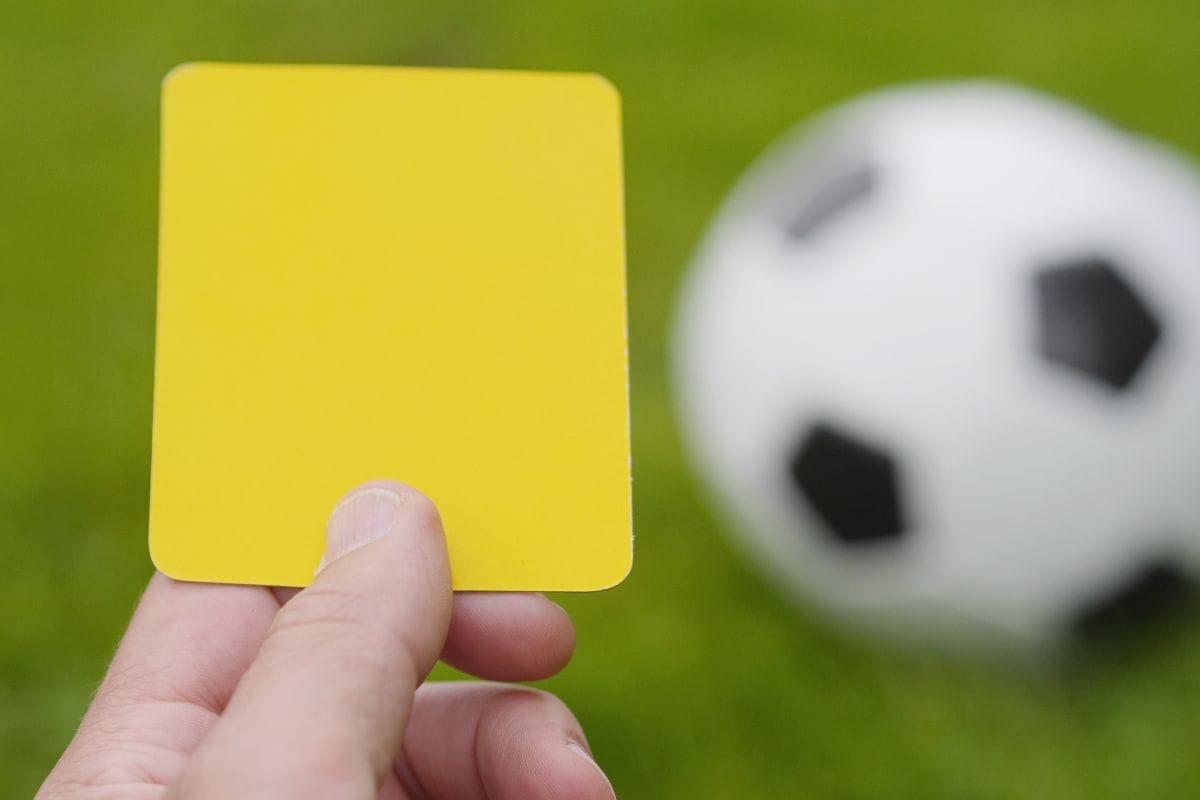
Yellow and red cards were most likely created in the 1960s when World Cup matches were causing issues in refereeing because of language barriers. The system of clear, color-coded cards that mean specific things was implemented as a universal language.
Yellow and red correspond to traffic light colors across the world, so it was easy for anyone to understand. Today, even people who are new to the game are able to understand the implications of each card, purely because of the colors.
The concept of yellow and red cards was introduced to FIFA by Ken Ashton, who went to them and suggested they used the system for the next world cup. This was then used in the 1970 world cup that took place in Mexico.
From that point onwards, it became a simple, standardized practice for the entirety of the world and it is used in almost every level of play.
Final Thoughts
So that was our comprehensive guide on what a yellow card means within soccer. Soccer can be a complicated game to understand for a new player or fan, especially when delving into the finer details of rules and restrictions.
However, many of the behaviors likely to land you with a yellow card can be avoided by just being respectful and courteous of others—be it your opponent, or teammates out on the field. As long as you continue to play the game without trying to cheat, the chances are that you won’t get booked.
We hope that this guide has helped you to understand the finer details of what a yellow card means in soccer.
If you still have some questions, make sure to check below for our Frequently Asked Questions section, where we will be going into detail on some of the finer points of this article. We wish you the best of luck in your next game of soccer, whether you are playing or spectating!
Frequently Asked Questions
What Does A Referee Write On A Yellow Card During A Game Of Soccer?
So one thing you’ve probably noticed during a game of soccer is that the referee will take out a pen and scribble something down onto a yellow card. But what are they doing exactly here, and why?
In short, a referee writing on a yellow card is just giving some details of the offense so that they remember it for later. This is sometimes synonymous with what soccer fans call ‘being booked.’ This is because it’s like they’re writing it in a book.
A referee will typically write a few main points of information. The first is the time in the game that the offense occurred, a referee can quickly check this by looking at their watch or any other time that they have access to. The second thing they will write is what the offense was, usually in a few simple words.
Thirdly, they will write the name or identity of the player in question. This is to stop any potential confusion from happening, especially if two players have the same or similar names.
Can A Manager Or Coach Get A Yellow Card?
You should know that managers and coaches can also get given yellow cards. This is something that happens within games of soccer, but it is rare to see. Coaches, managers, and any other official members of a team can also receive penalties for committing offenses during a soccer game.
This is because they can also have an effect on the game, so it’s important to make sure they don’t break the integrity of the sport by causing confusion, or distraction for the teams. Some of the most common reasons an official will get a yellow card include but are not limited to:
- Delaying play or restarting a game.
- Showing a lack of respect for the opposing team or game.
- Excessively gesturing for red or yellow cards for the opposing team.
- Gestures or words that show a lack of respect for the game.
- Leaving the confines of their technical area.
Any of these can cause a yellow card for the official, which can have implications for their team and even result in fines.
What Are The Responsibilities Of A Referee In Soccer?
Although referees are often only considered to be the person who enforces the rules of a game, they also have many other responsibilities.
This can sometimes include setting up a game, inspecting the field before and after to ensure it is safe, keeping the time of the game, and making any decisions to keep players on the field safe and secure.
Referees often have 2 assistant referees (in amateur and professional soccer/football) who are also called linesmen. Linesmen are there mostly to observe the offside rule, and carry flags to signal whether or not a goal was ‘onside’.
Communication between these linesmen is a vital part of soccer and something that you will see in almost every game of soccer (football).
What Is The Offside Rule In Soccer?
This is one of the most confusing rules for new fans of the sport to understand, but it’s a massively important part of soccer and something that can massively change the dynamic of games.
In short, the offside rule means that you cannot have a player behind the last line of the opposing team’s defense when being passed the ball. So let’s imagine there is a player in the opposing team’s back line, standing right outside of the goal box.
In this situation, they can simply wait to be passed the ball, and then they’re one-on-one with the keeper. The offside rule was created to stop this from happening, and any goals that happen within this situation are called out by the linesmen and then disallowed.

